
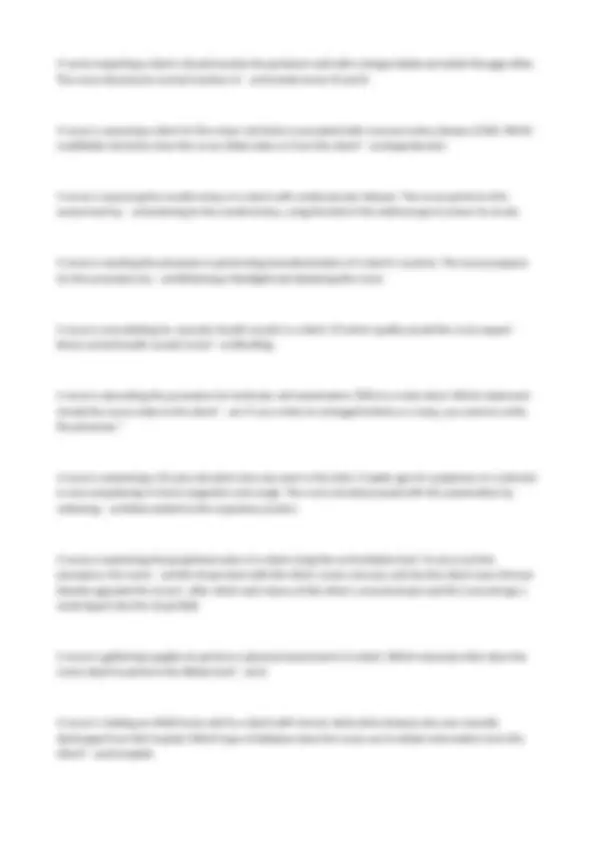
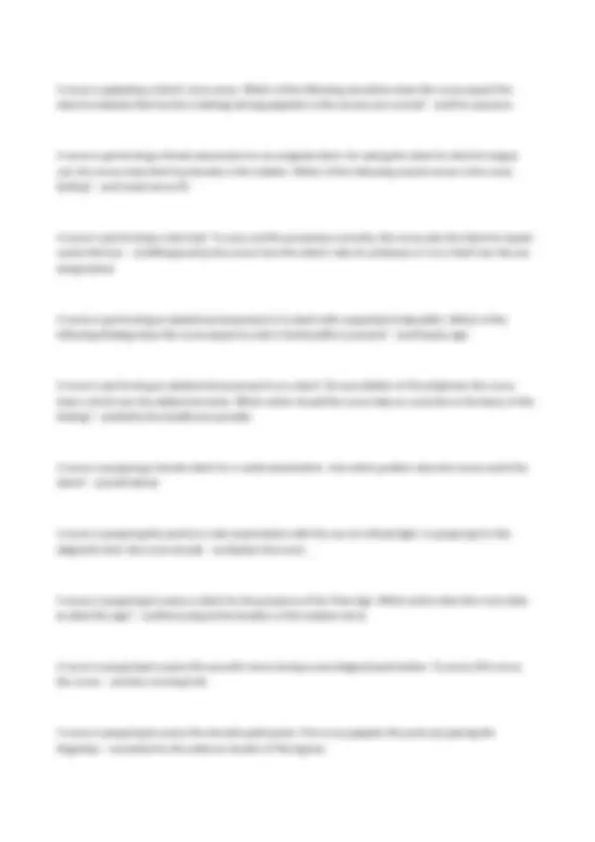
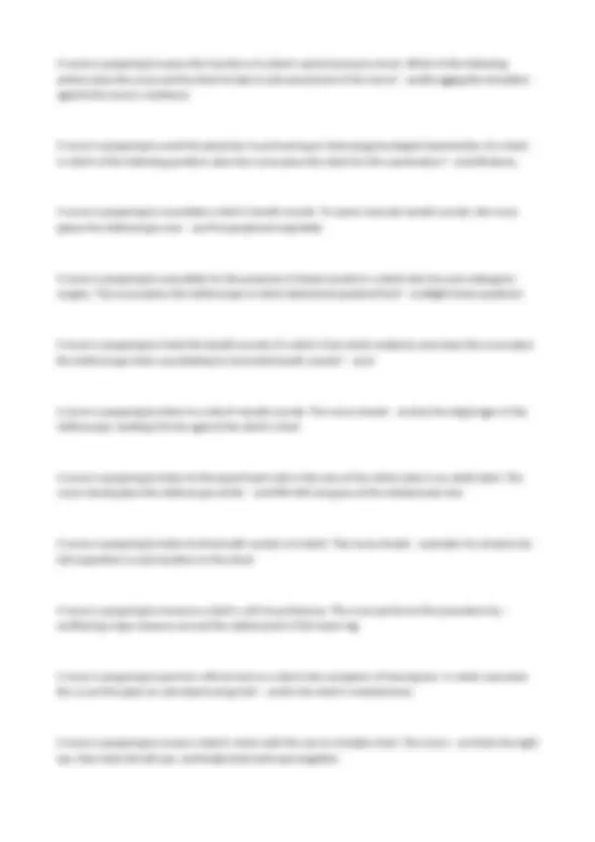
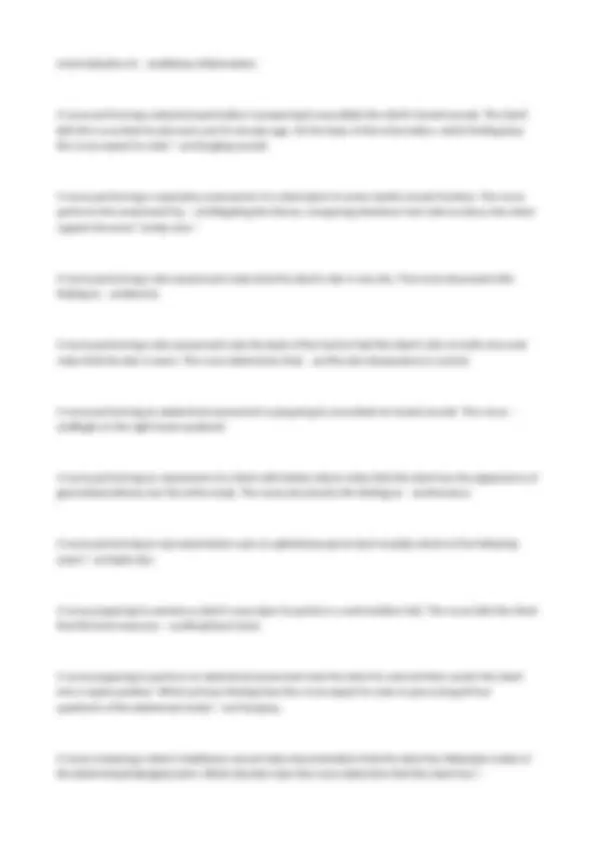
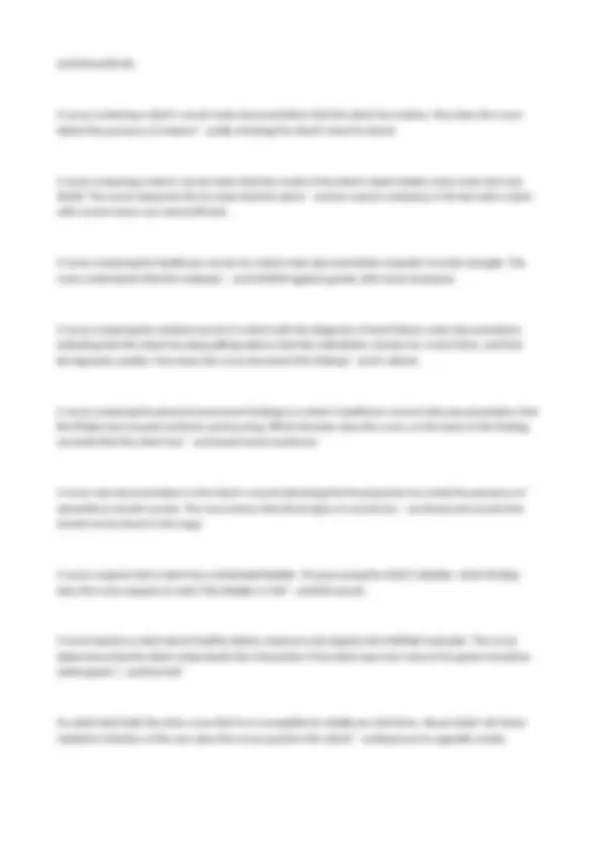
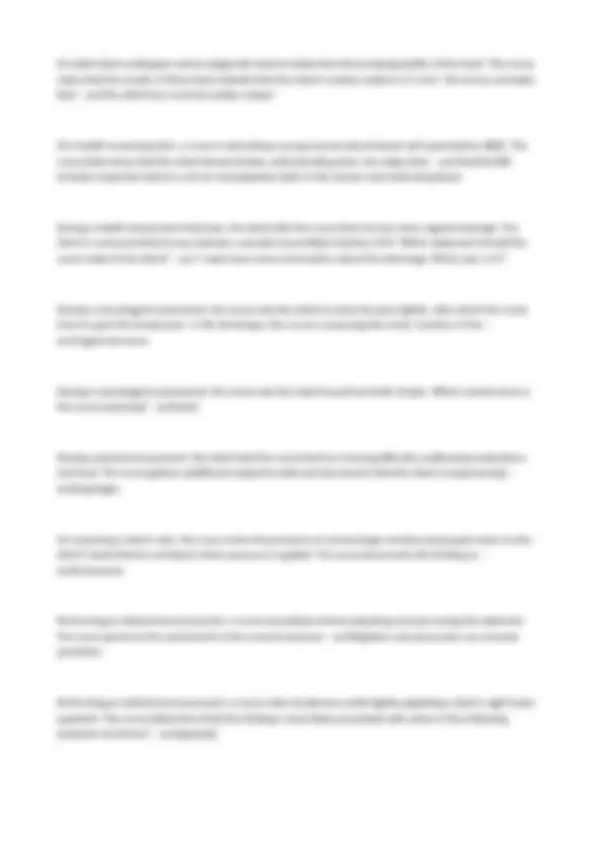


Study with the several resources on Docsity

Earn points by helping other students or get them with a premium plan


Prepare for your exams
Study with the several resources on Docsity

Earn points to download
Earn points by helping other students or get them with a premium plan
Community
Ask the community for help and clear up your study doubts
Discover the best universities in your country according to Docsity users
Free resources
Download our free guides on studying techniques, anxiety management strategies, and thesis advice from Docsity tutors
Health Promotion and Disease Prevention Exam with Correct Answers A 16-year-old girl visits the women's health clinic to obtain information about birth control because she is sexually active and wants to avoid pregnancy. The nurse who is interviewing the client should first: - ansAssess the client's knowledge of available birth control methods A 35-year-old female client asks the clinic nurse when she should begin to have yearly mammograms. What does the nurse tell the client? - ansYearly mammograms are recommended starting at age 40 A client complains that he feels as though his ear is blocked and tells the nurse that he has a history of cerumen impaction in the external ear. The nurse, inspecting the ears for cerumen impaction checks for: - ansA yellowish or brownish waxy material in the external auditory canal. A client complains that her skin is redder than normal. The nurse assesses the client's skin, documents hypermedia, and explains to the client that
Typology: Exercises
1 / 11

This page cannot be seen from the preview
Don't miss anything!







A 16-year-old girl visits the women's health clinic to obtain information about birth control because she is sexually active and wants to avoid pregnancy. The nurse who is interviewing the client should first: - ansAssess the client's knowledge of available birth control methods A 35-year-old female client asks the clinic nurse when she should begin to have yearly mammograms. What does the nurse tell the client? - ansYearly mammograms are recommended starting at age 40 A client complains that he feels as though his ear is blocked and tells the nurse that he has a history of cerumen impaction in the external ear. The nurse, inspecting the ears for cerumen impaction checks for: - ansA yellowish or brownish waxy material in the external auditory canal. A client complains that her skin is redder than normal. The nurse assesses the client's skin, documents hypermedia, and explains to the client that this condition is caused by: - ansExcess blood in the dilated superficial capillaries. A client is brought to the emergency department after a motor vehicle accident. The client is alert and cooperative but has sustained multiple fractures of the legs. How should the nurse proceed with data collection? - ansAsk health history questions while performing the examination and initiating emergency measures. A client who was given a diagnosis of hypertension 3 months ago is at the clinic for a checkup. Which type of database does the nurse use in performing an assessment? - ansFollow-up. A client with peripheral artery disease tells the nurse that pain develops in his left calf when he is walking and subsides with rest. The nurse documents that the client is most likely experiencing: - ansIntermittent claudication. A clinic nurse about to meet a new client plans to gather subjective data regarding the client's health history. Which of the following actions does the nurse take to help ensure the success of the interview? - ansEnsuring that the room is private. A community health nurse is instructing a group of female clients about breast self-examination (BSE). The nurse instructs the clients to perform the examination: - ansOne week after menstruation begins.
A female client is seen in the clinic for a gynecological examination. The nurse begins collecting subjective data. Which of the following topics does the nurse ask the client about first? - ansHer menstrual history. A Mexican-American client with epilepsy is being seen at the clinic for an initial examination. The nurse understands that the primary purpose of including cultural information in the health assessment is to: - ansDetermine what the client believes has caused the epilepsy. A mother brings her 18-month-old child to the clinic to receive the next scheduled vaccine. The child has previously received the following vaccines: three doses of the hepatitis B vaccine (at birth and 1 and 6 months of age); three doses of the diphtheria/tetanus/acellular pertussis (DTaP) vaccine (at 2, 4, and 6 months of age); four doses of Haemophilus influenzae type b (Hib) conjugate vaccine (at 2, 4, 6, and 12 months of age); three doses of inactivated poliovirus vaccine (IPV) (at 2, 4, and 6 months of age); one dose of measles/mumps/rubella vaccine (MMR) (at 12 months of age); varicella zoster vaccine at 12 months of age; and four doses of pneumococcal vaccine (at 2, 4, 6, and 12 months of age). After reviewing the child's immunization record, which scheduled vaccine does the nurse prepare to administer? - ansDTaP A nurse assessing a client's eyes notes that the pupils get larger when the client looks at an object in the distance and become smaller when the client looks at a nearby object. How does the nurse document this finding? - ansAccommodation. A nurse conducting a peripheral vascular assessment performs the Allen test. The nurse understands that this test is used to determine the patency of the: - ansRadial and ulnar arteries. A nurse conducting a physical assessment of a client plans to perform the Romberg test. After describing the test to the client, the nurse tells the client that it will help reveal: - ansA problem with balance. A nurse conducting an eye examination notes that the client exhibits rapid, involuntary oscillating movements of the eyeball when looking at the nurse. The nurse documents this finding as: - ansNystagmus. A nurse conducting an interview with a client collects subjective data. During the interview, the nurse: - ansTake minimal notes to avoid observation of the client's nonverbal behaviors. A nurse in the emergency department is performing a musculoskeletal assessment of a client. The presence of which of the following conditions would cause the nurse to avoid testing range of motion (ROM) of the cervical spine? - ansNeck trauma.
A nurse is palpating a client's sinus areas. Which of the following sensations does the nurse expect the client to indicate that he/she is feelings during palpation is the sinuses are normal? - ansFirm pressure. A nurse is performing a throat assessment on an assigned client. On asking the client to stick his tongue out, the nurse notes that it protrudes in the midline. Which of the following cranial nerves is the nurse testing? - ansCranial nerve XII. A nurse is performing a voice test. To carry out this procedure correctly, the nurse asks the client to repeat words that are: - ansWhispered by the nurse from the client's side at a distance of 1 to 2 feet from the ear being tested. A nurse is performing an abdominal assessment of a client with suspected cholecystitis. Which of the following findings does the nurse expect to note if cholecystitis is present? - ansMurphy sign. A nurse is performing an abdominal assessment on a client. On auscultation of the abdomen the nurse hears a bruit over the abdominal aorta. Which action should the nurse take as a priority on the basis of this finding? - ansNotify the healthcare provider. A nurse is preparing a female client for a rectal examination. Into which position does the nurse assist the client? - ansLeft lateral. A nurse is preparing the perform a skin examination with the use of a Wood light. In preparing for this diagnostic test, the nurse should: - ansDarken the room. A nurse is preparing to assess a client for the presence of the Tinel sign. Which action does the nurse take to elicit this sign? - ansPercussing at the location of the median nerve. A nurse is preparing to assess the acoustic nerve during a neurological examination. To assess this nerve, the nurse: - ansUses a tuning fork. A nurse is preparing to assess the dorsalis pedis pulse. The nurse palpates this pulse by placing the fingertips: - ansLateral to the extensor tendon of the big toe.
A nurse is preparing to assess the function of a client's spinal accessory nerve. Which of the following actions does the nurse ask the client to take to aid assessment of this nerve? - ansShrugging the shoulders against the nurse's resistance. A nurse is preparing to assist the physician in performing an internal gynecological examination of a client. In which of the following positions does the nurse place the client for this examination? - ansLithotomy. A nurse is preparing to auscultate a client's breath sounds. To assess vesicular breath sounds, the nurse places the stethoscope over: - ansThe peripheral lung fields. A nurse is preparing to auscultate for the presence of bowel sounds in a client who has just undergone surgery. The nurse places the stethoscope in which abdominal quadrant first? - ansRight lower quadrant. A nurse is preparing to check the breath sounds of a client. Over which anatomic area does the nurse place the stethoscope when auscultating for bronchial breath sounds? - ans2. A nurse is preparing to listen to a client's breath sounds. The nurse should: - ansUse the diaphragm of the stethoscope, holding it firmly against the client's chest. A nurse is preparing to listen to the apical heart rate in the area of the mitral valve in an adult client. The nurse should place the stethoscope at the: - ansFifth left inerspace at the midclavicular line. A nurse is preparing to listen to the breath sounds of a client. The nurse should: - ansListen for at least one full respiration in each location on the chest. A nurse is preparing to measure a client s calf circumference. The nurse performs this procedure by: - ansPlacing a tape measure around the widest point of the lower leg. A nurse is preparing to perform a Rinne test on a client who complains of hearing loss. In which area does the nurse first place an activated tuning fork? - ansOn the client's mastoid bone. A nurse is preparing to screen a client's vision with the use of a Snellen chart. The nurse: - ansTests the right eye, then tests the left eye, and finally tests both eyes together.
A nurse palpates a client's radial pulse, noting the rate, rhythm, and force, and concludes that the client's pulse is normal. Which of the following notations would the nurse make in the client's record to document the force of the client's pulse? - ans2+. A nurse performing a cranial nerve assessment is testing the function of the oculomotor, trochlear, and abducens nerves. Which of the following parameters does the nurse check to determine the function of these nerves? - ansEye movements. A nurse performing a genital examination of a male client notes that the skin of the penis and scrotum is wrinkled. On the basis of this finding, the nurse: - ansDocuments the normal finding. A nurse performing a musculoskeletal assessment of a client with suspected carpal tunnel syndrome plans to perform the Phalen test. The nurse should ask the client to: - ansHold the hands back to back while flexing the wrists 90 degrees for 60 seconds. A nurse performing a neurological assessment is inspecting the client's eyelids for ptosis. The nurse checks the client for: - ansDrooping. A nurse performing a neurological assessment is preparing to assess the optic nerve. The nurse performs this examination by: - ansAssessing visual activity. A nurse performing a neurological assessment of an adult client asks the client to identify various odors. In this technique, which cranial nerve is the nurse assessing? - ansOlfactory. A nurse performing a neurological examination is testing the cochlear portion of the acoustic nerve (cranial nerve VIII). Which of the following actions does the nurse take to test this nerve? - ansAsking the client to close his or her eyes and then indicate when a ticking watch is heard as the nurse brings the watch closer to the client's ear. A nurse performing a physical assessment of a client gathers both subjective and objective data. Which of the following findings would the nurse document as subjective data? - ansThe client states that he has a rash. A nurse performing a physical examination is assessing the client for costovertebral angle tenderness. When the nurse percusses the area, the client complains of sharp pain. The nurse interprets this finding as
most indicative of: - ansKidney inflammation. A nurse performing a physical examination is preparing to auscultate the client's bowel sounds. The client tells the nurse that he ate lunch just 45 minutes ago. On the basis of this information, which finding does the nurse expect to note? - ansGurgling sounds. A nurse performing a respiratory assessment of a client plans to assess tactile (vocal) fremitus. The nurse performs this assessment by: - ansPalpating the thorax, comparing vibrations from side to side as the client repeats the word "ninety-nine." A nurse performing a skin assessment notes that the client's skin is very dry. The nurse documents this finding as: - ansXerosis. A nurse performing a skin assessment uses the back of the hand of feel the client's skin on both arms and notes that the skin is warm. The nurse determines that: - ansThe skin temperature is normal. A nurse performing an abdominal assessment is preparing to auscultate for bowel sounds. The nurse: - ansBegins in the right lower quadrant. A nurse performing an assessment of a client with kidney failure notes that the client has the appearance of generalized edema over the entire body. The nurse documents this finding as: - ansAnasarca. A nurse performing an eye examination uses an opthalmoscope to best visualize which of the following areas? - ansOptic disc. A nurse preparing to examine a client's eyes plans to perform a confrontation test. The nurse tells the client that this test measures: - ansPeripheral vision. A nurse preparing to perform an abdominal assessment asks the client to void and then assists the client into a supine position. Which primary finding does the nurse expect to note on percussing all four quadrants of the abdominal cavity? - ansTympany. A nurse reviewing a client's healthcare record notes documentation that the client has Heberden nodes of the distal interphalangeal joints. Which disorder does the nurse determine that the client has? -
An adult client undergoes various diagnostic tests to determine the pumping ability of the heart. The nurse notes that the results of these tests indicate that the client's cardiac output is 5 L/min. The nurse concludes that: - ansThe client has a normal cardiac output. At a health screening clinic, a nurse is educating a young woman about breast self-examination (BSE). The nurse determines that the client demonstrates understanding when she states that: - ansMonthly BSE includes inspection before a mirror and palpation both in the shower and while lying down. During a health assessment interview, the client tells the nurse that she has some vaginal drainage. The client is concerned that it may indicate a sexually transmitted infection (STI). Which statement should the nurse make to the client? - ans"I need some more information about the discharge. What color is it?" During a neurological assessment, the nurse asks the client to close the jaws tightly, after which the nurse tries to open the closed jaws. In this technique, the nurse is assessing the motor function of the: - ansTrigeminal nerve. During a neurological assessment, the nurse asks the client to puff out both cheeks. Which cranial nerve is the nurse assessing? - ansFacial. During a physical assessment, the client tells the nurse that he is having difficulty swallowing medications and food. The nurse gathers additional subjective data and documents that the client is experiencing: - ansDysphagia. On assessing a client's skin, the nurse notes the presence of several large red-blue and purple areas on the client's body that do not blanch when pressure is applied. The nurse documents this finding as: - ansEcchymosis. Performing an abdominal assessment, a nurse auscultates before palpating and percussing the abdomen. The nurse performs the assessment in this manner because: - ansPalpation and percussion can increase peristalsis. Performing an abdominal assessment, a nurse notes tenderness while lightly palpating a client's right lower quadrant. The nurse determines that this finding is most likely associated with which of the following anatomic structures? - ansAppendix.
The nurse, performing an abdominal examination, inspects the client's abdomen. Which assessment technique does the nurse perform next? - ansAuscultation. While reviewing a client's health care record, a nurse notes documentation of the presence of borborygmus on abdominal assessment. Which of the following findings does the nurse expect to note when auscultating the client's bowel sounds? - ansHyperactive bowel sounds.